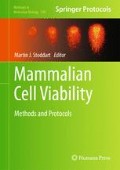Abstract
We describe here the use of the xCELLigence system for label-free and real-time monitoring of cell viability. The xCELLigence system uses specially designed microtiter plates containing interdigitated gold microelectrodes to noninvasively monitor the viability of cultured cells using electrical impedance as the readout. The continuous monitoring of cell viability by the xCELLigence system makes it possible to distinguish between different perturbations of cell viability, such as senescence, cell toxicity (cell death), and reduced proliferation (cell cycle arrest). In addition, the time resolution of the xCELLigence system allows for the determination of optimal time points to perform standard cell viability assays as well as other end-point assays to understand the mode of action. We have used the WST-1 assay (end-point viability readout), the cell index determination (continuous monitoring of viability by xCELLigence), and the DNA fragmentation assay (end-point apoptosis assay) to systematically examine cytotoxic effects triggered by two cytotoxic compounds with different cell-killing kinetics. Good correlation was observed for viability readouts between WST-1 and cell index. The significance of time resolution by xCELLigence readout is exemplified by its ability to pinpoint the optimal time points for conducting end point viability and apoptosis assays.
Access this chapter
Tax calculation will be finalised at checkout
Purchases are for personal use only
References
Riss, T.L. & Moravec, R.A. (2004) Use of multiple assay endpoints to investigate the effects of incubation time, dose of toxin, and plating density in cell-based cytotoxicity assays. Assay Drug Dev Technol 2, 51–62.
Mosmann, T. (1983) Rapid colorimetric assay for cellular growth and survival: application to proliferation and cytotoxicity assays. J Immunol Methods 65, 55–63.
Scudiero, D.A. et al. (1988) Evaluation of a soluble tetrazolium/formazan assay for cell growth and drug sensitivity in culture using human and other tumor cell lines. Cancer Res 48, 4827–33.
Berridge, M.V., Herst, P.M. & Tan, A.S. (2005) Tetrazolium dyes as tools in cell biology: new insights into their cellular reduction. Biotechnol Annu Rev 11, 127–52.
Nociari, M.M., Shalev, A., Benias, P. & Russo, C. (1998) A novel one-step, highly sensitive fluorometric assay to evaluate cell-mediated cytotoxicity. J Immunol Methods 213, 157–67.
de Fries, R. & Mitsuhashi, M. (1995) Quantification of mitogen induced human lymphocyte proliferation: comparison of alamarBlue assay to 3H-thymidine incorporation assay. J Clin Lab Anal 9, 89–95.
Shahan, T.A., Siegel, P.D., Sorenson, W.G., Kuschner, W.G. & Lewis, D.M. (1994) A sensitive new bioassay for tumor necrosis factor. J Immunol Methods 175, 181–7.
Petty, R.D., Sutherland, L.A., Hunter, E.M. & Cree, I.A. (1995) Comparison of MTT and ATP-based assays for the measurement of viable cell number. J Biolumin Chemilumin 10, 29–34.
Koop, A. & Cobbold, P.H. (1993) Continuous bioluminescent monitoring of cytoplasmic ATP in single isolated rat hepatocytes during metabolic poisoning. Biochem J 295 ( Pt 1), 165–70.
Crouch, S.P., Kozlowski, R., Slater, K.J. & Fletcher, J. (1993) The use of ATP bioluminescence as a measure of cell proliferation and cytotoxicity. J Immunol Methods 160, 81–8.
Garewal, H.S., Ahmann, F.R., Schifman, R.B. & Celniker, A. (1986) ATP assay: ability to distinguish cytostatic from cytocidal anticancer drug effects. J Natl Cancer Inst 77, 1039–45.
Kroemer, G. et al. (2005) Classification of cell death: recommendations of the Nomenclature Committee on Cell Death. Cell Death Differ 12 Suppl 2, 1463–7.
Ramirez-Ortega, M. et al. (2006) Proliferation and apoptosis of HeLa cells induced by in vitro stimulation with digitalis. Eur J Pharmacol 534, 71–6.
Weinstein, I.B. & Joe, A. (2008) Oncogene addiction. Cancer Res 68, 3077–80; discussion 3080.
Abassi, Y.A. et al. (2009) Kinetic cell-based morphological screening: prediction of mechanism of compound action and off-target effects. Chem Biol 16, 712–23.
Han, Y.H., Moon, H.J., You, B.R. & Park, W.H. (2009) The effect of MG132, a proteasome inhibitor on HeLa cells in relation to cell growth, reactive oxygen species and GSH. Oncol Rep 22, 215–21.
Yim, E.K. et al. (2004) Proteomic analysis of antiproliferative effects by treatment of 5-fluorouracil in cervical cancer cells. DNA Cell Biol 23, 769–76.
Singh, S., Upadhyay, A.K., Ajay, A.K. & Bhat, M.K. (2007) Gadd45alpha does not modulate the carboplatin or 5-fluorouracil-induced apoptosis in human papillomavirus-positive cells. J Cell Biochem 100, 1191–9.
Author information
Authors and Affiliations
Corresponding author
Editor information
Editors and Affiliations
Rights and permissions
Copyright information
© 2011 Springer Science+Business Media, LLC
About this protocol
Cite this protocol
Ke, N., Wang, X., Xu, X., Abassi, Y.A. (2011). The xCELLigence System for Real-Time and Label-Free Monitoring of Cell Viability. In: Stoddart, M. (eds) Mammalian Cell Viability. Methods in Molecular Biology, vol 740. Humana Press. https://doi.org/10.1007/978-1-61779-108-6_6
Download citation
DOI: https://doi.org/10.1007/978-1-61779-108-6_6
Published:
Publisher Name: Humana Press
Print ISBN: 978-1-61779-107-9
Online ISBN: 978-1-61779-108-6
eBook Packages: Springer Protocols

